Daily sampling at all stages of development can quickly identify pathogens and improve biosecurity
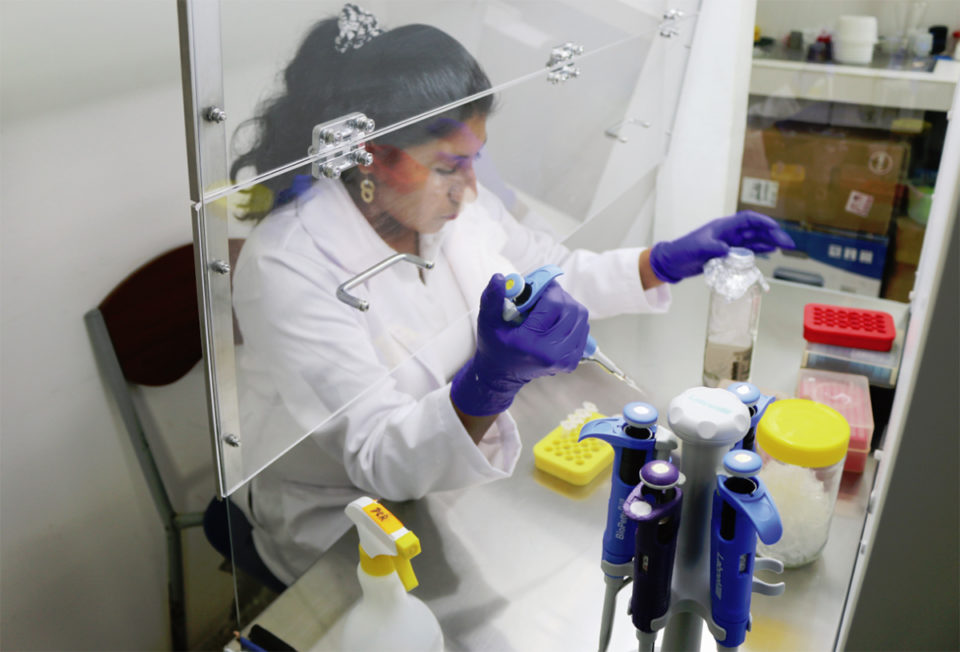
Editor’s note: This article is adapted and summarized from Aquacultura #120 (Ecuador) Nov. 2017, the official publication of the National Aquaculture Chamber of Ecuador. The country is one of the world’s top producers of farmed shrimp, and its hatchery industry and its biosecurity are key components of this production chain.
In a recent visit to the Biogemar shrimp hatchery, located in Santa Paula, Salinas, Ecuador, in the province of Santa Elena, we learned about its biosecurity protocols and measures. Currently the focus is on the importance of promoting responsible larviculture with preventive measures and good management practices. The objective is to minimize the risk factors and the presence of pathogens and their potential dispersion within the facility and to other facilities.
Producing quality Pacific white shrimp (Penaeus vannamei) postlarvae is the result of complying with a set of sanitary measures, such as asepsis – the state of being free from microorganisms that cause diseases, including pathogenic viruses, bacteria, parasites and fungi – in all processes and preventing the entry of infected and diseased animals.
Ecuador’s shrimp farming sector requires production of 5.5 billion larvae per month, according to Alex Elghoul, principal vocal of the National Chamber of Aquaculture. Shrimp hatcheries work to fulfill this significant demand, but there have been some challenging times. Currently, there is a concerted effort to improve biosecurity measures, including physical resources – with all equipment, filters, access controls, ponds, liquid culture media and others – as well as biological aspects like stocking densities, sanitary sampling and elimination of vectors, among others.
Walter Intriago, general manager of Biogemar, says there is a shortage of products that are very necessary, like probiotics that are used to displace pathogenic bacteria. He also stated that some shrimp larvae producers make important investments to produce quality larvae, that their success goes beyond the tangible, and that qualified personnel is required.
“The fact is that increasing infrastructure does not mean increasing production, but removing pressure on the systems, like having a much longer sanitary time period. If previously we considered an eight-day dry-out of the hatchery, now we have doubled it and this allows us to do more thorough disinfections,” says Intriago.
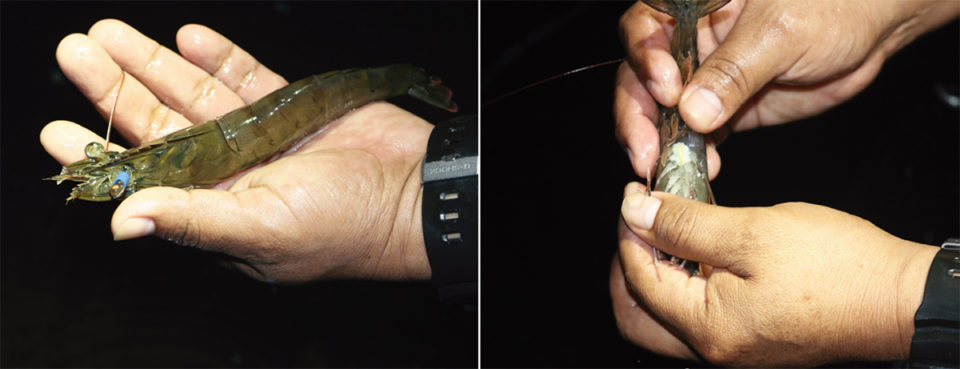
Selecting healthy broodstock
Without exception, all prospective broodstock animals brought from a shrimp farm go through a quarantine area and are thoroughly checked to prevent the entry of infected and sick shrimp into the maturation area. Once results are available, a selection protocol is carried out, with animals separated by batches and distributed into the 14 tanks that Biogemar has in one of its maturation rooms.
“It is a process of genetic improvement and therefore we must keep track of each broodstock animal that comes in. Biogemar keeps data of the production cycle of each batch, and is able to determine which batch yielded good egg and postlarvae production of eggs. We choose their descendants to go to the shrimp production ponds and we try to get these animals back as adult shrimp into our production center,” says Milton Tomalá, head of maturation production.
A sex ratio of two females per male is maintained in the breeding tanks. During this stage, the broodstock animals are fed with artemia biomass, squid, Chilean mussels and manufactured aquafeeds.
Regarding water quality, the most important parameters maintained in this area include water temperature of 28 degrees-C with a maximum of 34 degrees-C, with strong aeration in the center of the tanks. Water exchange must be done daily to create and maintain an environment conducive to reproduction, in low light conditions and, above all, distanced from any noise that may disturb the broodstock animals.
The females spawn every three to four days per week and release 200,000 to 250,000 eggs, depending on animal size; 15 days after being harvested they begin to be productive organisms.
Broodstock remain in the maturation area for 90 days, and are then replaced by a new group of progenitors. The closed-cycle system allows the continuous collection of “virus-free” broodstock and a longer-term genetic selection.
“Once they copulate, males take three to four days to regenerate their sperm and again mate with females; there are months when they eat more because of the weather, and therefore they are more likely to reproduce,” said Tomalá.
The objective is to maintain the unit at its optimal production level and prevent non-productive animals to remain in the system. In order to comply with this, it is necessary to monitor the spawning amounts on a daily basis and to establish average numbers at the end of each week.
The biologist and the technicians detect gravid females daily and observe the level of development of the gonads using a portable lamp. The selected female is carefully collected with a clean dipnet, as gravid females must be handled carefully.
The spawning room should be ready to receive pregnant females and it is essential to follow all sanitary regulations when these animals are collected. It is important that each female is fully identified with the number of its maturation tank; this is a fundamental procedure so that each spawn is isolated and never mixed with others so that traceability can be maintained.
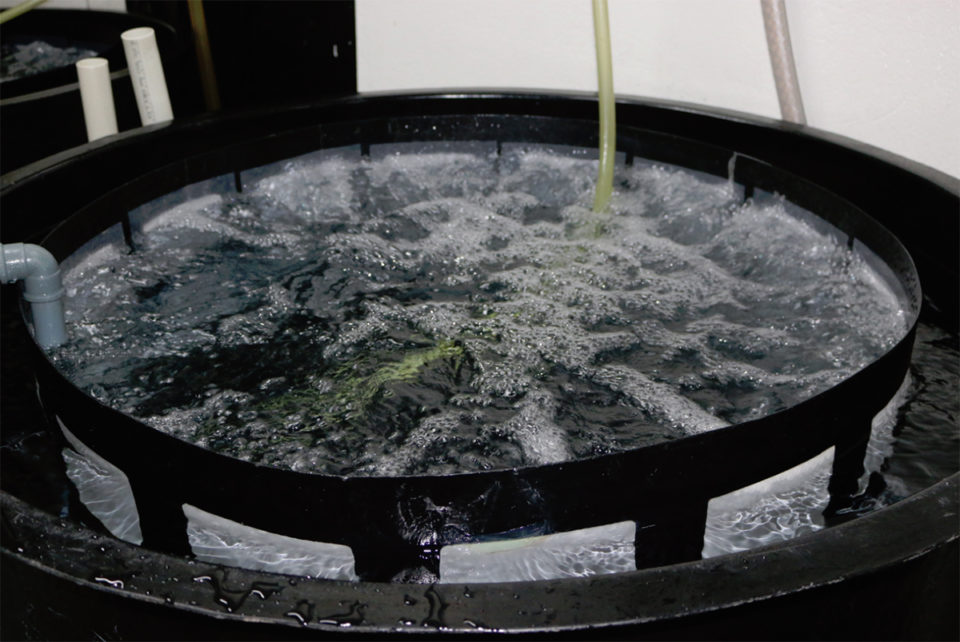
Eggs should be cleaned of all fecal waste, and they are first passed through a 200μ mesh and recovered in a 100μ mesh, always keeping the eggs in water. The eggs are then transferred to buckets to assess the quantity and quality of each spawn, and then are moved to the hatching area. There, the eggs are evenly distributed over the mesh of the hatching system, preventing their agglomeration. The flow of filtered water (5μ) from bottom to top provides adequate dissolved oxygen levels. This hatching system must be kept completely dark except for a hole in the lid, at the level where water comes out.
Good quality nauplii actively move by positive phototropism towards the hole in the lid, a luminous spot, where they are carried by the water flow to the recovery system. This procedure selects only the best quality nauplii, easily identified because they are the ones that can swim actively while lower quality nauplii remain in the mesh.
“We count and separate 8 to 10 million nauplii per basket, then once you have all the harvest of the day, disinfection and a good exchange of water are done, and then they are saved again in the storage area for the next day, at a temperature of 33 degrees-C,” said Tomalá.

Attention to water quality essential in larviculture
In the larval production tanks, Biogemar works with 20-day cycles where they rear from nauplii to postlarva 12. Once the stocking date is set, the water is first treated, the temperature is regulated to 29 degrees-C and the air column is checked to maintain optimum dissolved oxygen levels.
Currently, when nauplii are received, they receive a primary feeding with Tetraselmis microalga and the initial temperature of 29 degrees-C is maintained. As the metamorphosis proceeds, the larval food is changed to the microalga Thalassiosira and the temperature is regulated using heating coils until it reaches 33 degrees-C.
At Biogemar there are 24 tanks, but according to José Zambrano – head of larval production – each one yields a different result “despite the fact that they have the same maturation, the same diet, the same intake of water, the same temperature; but the difference is that each tank is a different world, because the larvae do not behave in the same way, for reasons that are beyond our knowledge.”
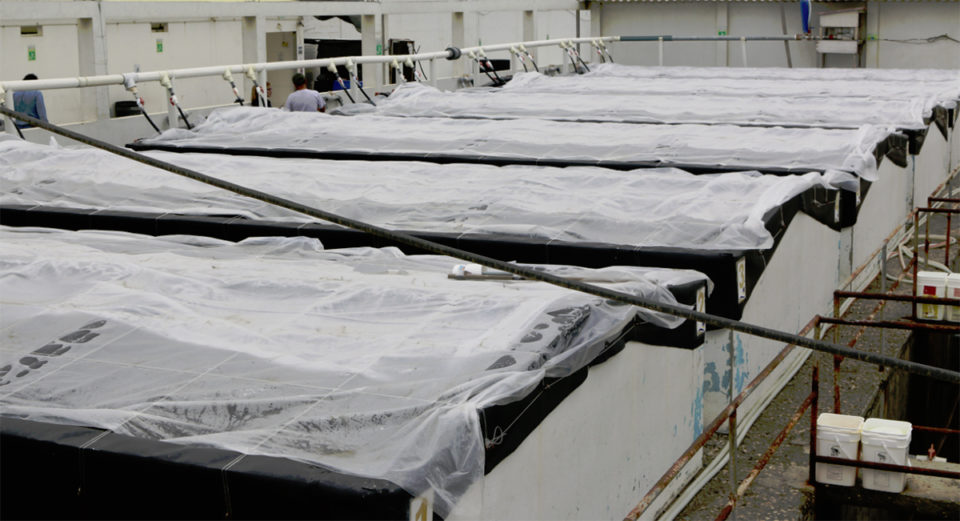
Monitoring to control the evolution of the larvae is a permanent endeavor, explains Zambrano, because it is necessary to timely identify if there is a delay in the growth of the larvae and to discard problems regarding the production process; aeration problems, water quality, chlorine residues, food deficiencies, among other factors, can promote animal deformities. Regarding asepsis, every tank geomembrane is carefully cleaned after every larval production run, taking into account that it is customary to stop for around 12 days to do a general disinfection.
“It is necessary to prevent too much organic matter in the ponds because it can promote the growth of protozoa that adhere to the shrimp gills and obstruct the breathing of the animals. If the microalgae fall to the tank bottom and bubbles form, animals can become entangled in it; metamorphosis can be delayed in weak larvae that are not eating, but if the animals are strong they can molt. These are the particularities of each larval production run,” said Zambrano. “It is better to discard animals when small and not continue spending on food, maintaining what later on I will not recover, but if I see that something can be treated by 50 percent, then I see a cost benefit.”
The Biogemar larval production area sends samples to the pathology laboratory at least twice a week, to look for the presence of some pathogens. If any pathogens are confirmed, the biologist must decide the course of action for the affected tank and if it is possible to recover some of the animals or just discard them. The larvae are kept for 22 days in the hatchery and then they go out to the shrimp farms.
Challenge: preventing germ entry in live food production
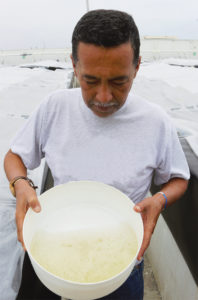
Various microalgae remain an indispensable live food for larvae, and are typically grown in treated, natural seawater enriched with additional nutrients like nitrates, phosphates, essential trace elements, vitamins and carbon dioxide.
For Vicente Ricardo Rodríguez, in charge of the Biogemar algae laboratory, the starting point is to prevent the entry of contaminating agents into the area; they implement personnel disinfection protocols and wear sterilized clothing daily.
One of the main processes to comply with asepsis is the cleaning of all glass equipment. Containers are cleaned and disinfected with neutral soap and diluted acid, are then allowed to dry and are then sterilized under high pressure and temperature.
At the Biogemar algae laboratory, strains of the microalgae Tetraselmis and Thalassiosira are grown, and the colonies are kept under stable conditions so they continue to divide and renew. Microalgae are collected and transferred in a liquid medium to inoculate filtered and sterilized, 34-ppt salinity enriched with various nutrients. The process is then repeated using progressively larger vessels and recued densities, and using specific fertilization protocols for each. The microalgae laboratory can inoculate 50 tons of seawater per day, 25 tons each for Tetraselmis and for Thalassiosira.
With larger volume inocula, it is advisable to increase the level of illumination and aerate the culture with a mixture of air or carbon dioxide. It is also advisable to dilute the medium to grow diatom species up to a salinity of 20 to 25 PSU (practical salinity units, equivalent to parts per thousand) in order to obtain the best growth rates.

Biology department is essential
Various diseases are the main cause of massive mortality of larvae, representing significant economic losses for producers because sometimes hatcheries must discard the entire production of tanks when the presence of pathogens is confirmed. That is why it is essential to have an adequate biology laboratory to detect the presence of pathogenic viruses, various intracellular microorganisms, bacteria, fungi, internal and external protozoans, epicommensal organisms, toxins and other factors.
Biogemar’s biology department has state-of-the-art equipment that allows rapid and efficient analysis, with the process beginning with DNA extraction and polymerase chain reaction (PCR).
“The extraction is done outside, once the DNA has been extracted, the reagent is prepared in the laminar flow chamber, which is sterile and has UV, that is to say, there is no contamination here and that help results being as true as possible,” explained Mery Yagual, head of the biology department. This laboratory detects shrimp diseases like Early Mortality Syndrome, aka Acute Hepatopancreatic Necrosis Disease (EMS/AHPND).
It is very important to have a department of biology that carries out daily sampling at all stages of development of the animals, to quickly identify the possible presence of pathogens so that appropriate actions can be taken where the time factor can be determinant for the survival or mortality of the larval shrimp.

Recommendations
In conclusion, it is recommended that the larval quality is evaluated first at the laboratory of origin, and to rigorously follow and apply a bio-safety program that must contain at least the following points:
- Regulations for visitors and access control.
- Measures for water quality control.
- Cleaning and disinfection procedures.
- Measures for the management of waste and the control of wild organisms.
- Protocols for technical management in the aquaculture facility.
- Measures to be applied in case of polluting outbreaks.
- Protocols for the isolation and quarantine of shrimp.
Author
-

Shirley Suasnavas, Msc.
Communications Director
National Aquaculture Chamber
Guayaquil, Ecuador
Tagged With
Related Posts

Health & Welfare
A comprehensive look at the Proficiency Test for farmed shrimp
The University of Arizona Aquaculture Pathology Laboratory has carried out the Proficiency Test (PT) since 2005, with 300-plus diagnostic laboratories participating while improving their capabilities in the diagnosis of several shrimp pathogens.

Aquafeeds
Biosecurity protocols needed for shrimp feeds, feeding practices
Shrimp aquafeeds – live, fresh or formulated – should not be an entry point of potential pathogens to the shrimp and/or to their culture systems.

Aquafeeds
Global brine shrimp supply a potential bottleneck to aquaculture expansion, part 1
The brine shrimp artemia is critical for larval fish and shrimp diets. As aquaculture expands, an effective artificial replacement diet for artemia is a major consideration for the industry.

Health & Welfare
A holistic management approach to EMS
Early Mortality Syndrome has devastated farmed shrimp in Asia and Latin America. With better understanding of the pathogen and the development and improvement of novel strategies, shrimp farmers are now able to better manage the disease.

